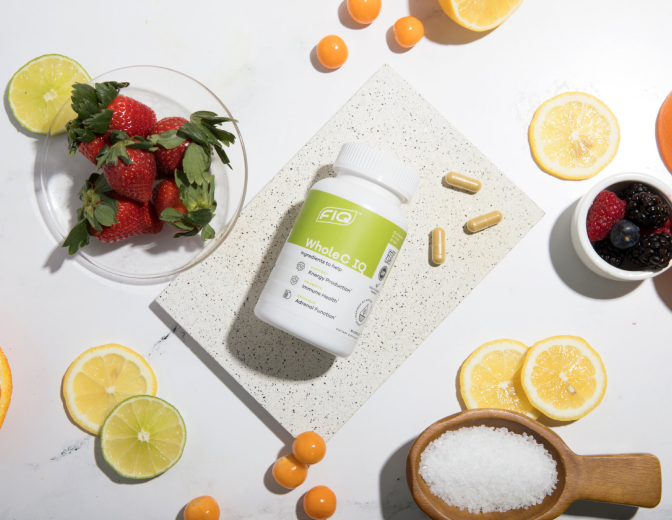GDAs are classified as ‘natural agents that aid in shuttling glucose out of the blood and into the cell, effectively lowering blood sugar levels.’
While this is certainly better than having high blood sugar, diabetes is far more than just high blood sugar. Simply disposing of glucose in the cells does effectively get to the root cause.
What’s Really Going on in Diabetes
For most people with T2D, insulin resistance (IR) is the ‘root cause.’ Thishappens when cells stop responding to insulin appropriately.2Insulin is an essential hormone that manages blood sugar levels by shuttling glucose inside cells to store as glycogen or make energy. When muscle, liver, fat cells aren’t ‘listening’ to insulin, beta cells of the pancreas make more of it - effectively creating a ‘louder’ signal.
Studies show that insulin resistance is present 10-15 years before blood sugar and A1c are ever impacted.2 During this time, insulin levels consistently increase.
Your doctor may be able to tell if you’re headed towards a diabetes diagnosis a decade in advance simply by testing your insulin levels rather than just fasting glucose and A1c.3
When cells becomes insulin resistant, it shifts to a ‘metabolically deranged’ state, leading to oxidative stress and chronic inflammation.4 It’s common to also see imbalanced cholesterol levels, high blood pressure, and obesity, along with insulin resistance - aka “metabolic syndrome.”5
with prolonged IR and chronic inflammation, the beta cells of the pancreas can’t keep up with the body's insulin demands. They eventually become impaired (producing very little insulin), or they stop working altogether.6
It’s stands to reason that just “disposing of glucose” into the cell may not be the most well-rounded approach for dealing with these myriad health concerns.
A Better Way to Support Glucose Levels
A more powerful approach addresses and protects all factors of this system, not just the endpoint.Insulin resistance itself has its own ‘root cause(s),’ including:
- Excessive processed carb intake7
- Excess fat in the liver8
- Inflammation5
- A sedentary lifestyle9
- Genetic + epigenetics/environmental interactions10
- PCOS/hyperandrogenism (in women)11
In terms of natural agents that one could take in addition to these lifestyle habits, the most impact will come from those that not only enhance glucose uptake at the cell but also:
- Lower inflammation an clean up oxidative stress
- Reduce insulin resistnace
- Protect pancreatic beta cell health
- Support systems and organs impacted by high blood sugar
Full-Spectrum Glucose Metabolism Support
Banaba Leaf
From the leaves of Asian crepe myrtle trees, this herb has shown potent GDA properties along with various other metabolic benefits.14 Corosolic acid and ellagitannins offer insulin-like activity.15 Several human studies found decreases in fasting blood sugar by up to 30%.14 It is also noteworthy the banaba leaf lowered blood sugar but did not cause hypoglycemia in these subjects.Other studies show that banaba slows the rate of glucose absorption following meals, reducing post-prandial glucose spikes.14 It also promotes weight loss,16 lowers blood pressure, reduces inflammation and oxidative stress,17 is liver-protective, and beneficially influences blood lipids.14
Chanca Piedra
Elevated blood sugar is toxic to kidney health. Chanca Piedra is an ancient kidney remedy known as the “stone breaker,” thanks to its potent actions against kidney stones.18 In addition to supporting kidney health, it is also known to lower blood sugar due to its antioxidants.19 It is thought to express hypoglycemic actions by modulating enzymes and antioxidants associated with hyperglycemia,20 effectively addressing oxidative stress associated with insulin resistance and high blood sugar.It is also liver-protective,19 protective against H.pylori, is antibacterial,21 and lowers blood pressure.18
Berberine
Berberine is a classic GDA. Many have called it “nature’s metformin” for its blood sugar-lowering effects. But this herb does far more than enhance glucose disposal. It also impacts the microbiome, the liver, and various other organs.Berberine possesses potent anti-bacterial properties and beneficially influences the gut microbiome balance and imrproves dysbiosis. An imbalanced gut environment can lead to chronic inflammation. The influence on gut health may be a foundational mechanism of berberine to improve blood sugar.22
Berberine also lowers blood sugar by enhancing insulin secretion, stimulating glycolysis (the breakdown and utilization of glucose in the liver and muscles), inhibiting the endogenous production of glucose within the liver (called gluconeogenesis), and improving insulin resistance.22
Neem leaf
Like berberine, neem leaf possesses diverse physiological impacts across various systems and pathways. It has anti-inflammatory, antibacterial, antimicrobial, and immune-boosting properties, along with GDA benefits.23.Neem leaf improves blood sugar levels in various ways. It acts on the insulin receptor to improve insulin sensitivity,24 increases insulin release, reduces enzymes that inhibit GLP-1, protects pancreatic beta cells, and increases glucose conversion to ATP-energy.25
Gymnema Sylvestre
Gymnema has long been recognized for it’s poweful blood sugar-regulating effects. A recent meta-analysis confirms it’s ability to reduce fasting and post-prandial blood sugar levels, and improve A1c and lipids.26Gymnema is also unique in that it has been shown to reduce sugar cravings and make sweet foods taste less sweet.27, 28
Most notability is the powerful protective effects it offers to pancreatic beta cells.29 Gymnenma has been shown to regenerate beta cells30 (which are very hard to do once they’re lost), and improve insulin output.
Bitter Melon
Bitter herbs are historically recognized for their ability to increase digestive enzyme output when with meals. Bitter melon offers an additional benefit in that it improved blood sugar metabolism as well. It works as an “insulin memetic,” meaning it mimicks the actions of insulin.31Bitter melon posesses various insulin memtic molecules. The most notable is plypeptide-p, also known as ‘p-insulin’ that shows powerful insulinemic effects. It’s also protective to pancreatic beta cells, suppresses glucose digestion and absorption, increases insulin output, and stimulates glycolysis.31
More than Just Glucose Disposal
Glucose IQ features these key ingredients that each posses unique glucose-disposing properties while also supporting the various related systems that are impacted by glucose metabolism.Not only do these combination ingredients help to suppress sugar cravings and reduce glucose digestion and abosorption, they also protect he very cells involved in glucose regulatory processes, stimulate a healthy cellular glucose/insulin response, influence insulin senstivity, regulate inflammatory processes, and protect organs impacted by high blood sugar and insulin resistance.
Taken with each meal, many customers have reported great results with Glucose IQ.




